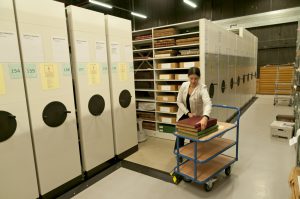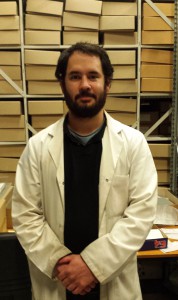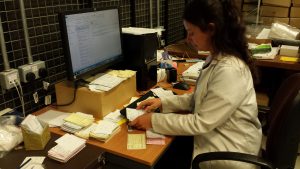August 26, 2016, by Kathryn Steenson
Beyond the Reading Room: Document Production
It’s 10 years this month that Manuscripts & Special Collections moved to King’s Meadow Campus! Many people have visited the Reading Room over the years, but this is only a small part of the department. As part of the celebrations, we’re giving you a look at what goes on Beyond the Reading Room, continuing with…
Abigail and Matt, Document Production Assistants.
Production
Many people at KMC will be familiar with the sight of Abigail and Matt, clad in white lab coats, pushing trollies of brown boxes between the Store and the Reading Room. Their primary role is to fetch the archives and books that people request and bring them to the Reading Room, and then return them afterwards.
This is by far the most physically demanding job in Manuscripts & Special Collections. Unlike the other seven branches of the library, the vast majority of books and documents are in closed stacks and must be brought to visitors.
Any boxes requested in advance are carefully labelled with the visitor’s name and the date and placed in a holding area in the Store. Each morning, before the doors are opened, the boxes for that day are brought to the Reading Room. Although we don’t turn people away if they haven’t made an appointment, with 5 miles of shelving in the Store it can take up to half an hour for Abigail and Matt to fetch the material.

They make this trip several times throughout the day, bringing researchers more material and taking away the boxes no longer needed. In between trips, they will check the appointments diary, fetch material for copying orders, and generally ensure that everything is in the right box, on the right shelf.
Why the white coats? The Store is climate-controlled and there are strict limits on the humidity and temperature, which should be between 13C and 18C. This is ideal for paper and parchment, but anyone spending a long time working in there is likely to get quite chilly. The second reason is that some of the material can be quite grubby. Deeds that were kept in a solicitor’s office with an open fire are often coated in a fine layer of soot, and leather used to bind volumes can develop a reddish-coloured dust called ‘red rot’ that can cling to clothing.
Preservation
As the people who handle the archive material more than anyone else, Matt and Abigail are in the best position to spot items which are fragile or could be damaged if handled. For single sheets of paper or photos, sometimes all that’s needed is to put it in a clear polyester sleeve, but anything more complicated is flagged up for the attention of the Conservator.
Part of their job is to check the conditions in the Store daily, which involves yet more walking. The collections in the Store are incredibly precious and even mundane events such as water leaks or insects nesting could be devastating.
Between February and April, researchers consulted 2918 books and documents in the Reading Room. The reason we know this is because part of Abigail and Matt’s role is to help collate the quarterly statistics of how many books and documents are produced in the Reading Room and by whom. In that respect, it’s similar to tracking library circulation statistics, except that the document request system is paper based, and this means a lot of counting!
Manuscripts & Special Collections on King’s Meadow Campus holds the University’s collection of rare books and archives. More information about the collections and how to access them is available on our website.
We’re holding an Open Day to celebrate our 10th anniversary on Friday 9th September. There will be an opening ceremony for our newly refurbished Reading Room, displays, behind-the-scenes tours, goodie bags and refreshments. If you’d like to join us, please email us at mss-library@nottingham.ac.uk.
No comments yet, fill out a comment to be the first



Leave a Reply